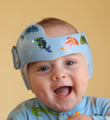A clinical report in the December issue of Pediatrics concludes that cranial orthoses should be considered only for infants with severe cases of deformity or for those whose deformity does not improve after six months of age. Surgical correction is only recommended for circumstances in which a child has persistent, severe deformities that have not adequately been corrected despite all other non-operative measures. The intent of this report is to provide guidance for the prevention, diagnosis, and management of positional skull deformity in an otherwise normal infant without evidence of associated anomalies, syndromes, or spinal disease.

The push to put babies to sleep on their back to reduce the risk of sudden infant death syndrome (SIDS) has been associated with a decrease in the incidence of SIDS but has led to an increase in flat heads. However, positional skull deformities are generally benign, reversible head-shape anomalies that do not require surgical intervention, as opposed to craniosynostosis, which can result in neurological damage and progressive craniofacial distortion. Although associated with some risk of positional skull deformity, healthy young infants should be placed down for sleep on their backs. Pediatricians need to be able to properly differentiate infants with benign skull deformities from those with craniosynostosis, educate parents on methods of proactively decreasing the likelihood of the development of occipital flattening, initiate appropriate management, and make referrals when necessary.
The writing committee was led by James Laughlin, MD, assistant clinical professor of pediatrics, Indiana University (IU) School of Medicine, Bloomington.




